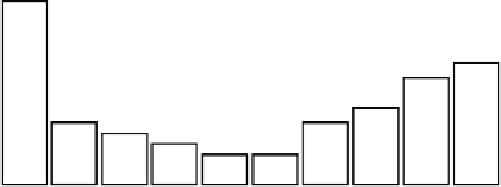Environmental Engineering Reference
In-Depth Information
For example, there are some places inside the object “Shelter” (previously called “Sarcophagus”)
with high levels of contamination. “Shelter” was built in 1986 in order to localize and subsequently
control the situation of nuclear fuel from the destroyed reactor of the fourth block of Chernobyl NPP.
The fallout on the earth's surface slowly migrates deep into the soil. For 25 years after the
accident, the property of the primary fallout changed. Secondary airborne aerosol particles were
formed due to winds, forest ires, and also technogene activity (moving transport, building, and
agriculture activity).
The data in this chapter is unique, because it is impossible to repeat such a situation due to the
exclusiveness of the accident. Even now, for example, when we measure the radioactive aerosol
concentration inside the “Shelter,” the smallest change in meteorological conditions (temperature,
pressure, humidity, speed and direction of the wind) and some technogene activity results in
changes in the physicochemical characteristics of aerosols in the same sampling point.
It should be understood under what circumstances the measurements in the irst weeks and
months after the accident were taken. Dosimetric control of inner irradiation air sampling was
provided in extreme conditions. In some sites, the radiation levels were so high that dosimetric
personnel who would spend just a couple of minutes or hours would endanger their health. Often it
was dificult to study the samples carefully, and dosimetrists were restricted only to measuring the
summary of gamma- and beta-activity of the sample.
Still we hope that these materials, the majority of which were obtained by scientists and techni-
cians of the aerosol laboratory of Karpov Institute of Physical Chemistry, will inform readers of the
main properties of radioactive aerosols and the gaseous products of the accident in Chernobyl NPP.
18.2 DYNAMICS OF THE EJECTION OF RADIONUCLIDES
FROM THE REACTOR
On April 26, 1986, as a result of the explosion in the fourth block of Chernobyl NPP, the core and
upper part of the reactor were completely destroyed, as were all defense barriers and systems of
security. It was the largest accident in the atomic industry. Most of the radionuclides were ejected
from the fourth block from April 26 up to May 6, 1986 [1]. The dynamics of the ejection are shown
in Figure 18.1.
In the irst day after the accident, aerosol sampling and analysis of sampling composition above
the destroyed reactor already began. Due to many factors (nonstationary character of the ejec-
tion, meteorological conditions, intensive work on covering the destroyed reactor with different
700
600
500
400
300
200
100
0
26
27
28
29
30
1
2
3
4
5
6
April
May
FIGURE 18.1
Daily integral ejection of radioactive products (without inert gases) from destroyed reactor
block of the Chernobyl NPP in April-May 1986.






Search WWH ::

Custom Search